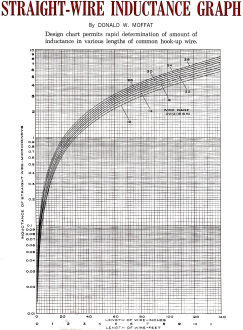Straight-Wire Inductance Graph
|
|
Sure, there are many straight-wire inductance graphs around, and dozens of phone apps available for use. However, here you are looking at this one from a 1966 issue of Electronics World magazine, so you might as well click on it to get the full-size version, then print it out for taping up on your workshop wall. Curves are provided for 10, 14, 18, 22, 26, 30, 34, and 38 gauge wire, lengths ranging from 0 up through 140 inches (~12 feet). Interpolate between the curves for in-between size wires. In case you're wondering (because you haven't clicked to see the big version of the graph), the inductance from about 25 nH for 1 inch up through about 8.4 μH at 140 inches (#38 wire). Note that in the article logε is the natural logarithm (ln) function. When the equation given is entered into Excel and the diameter of #30 wire (0.01003 in, or 0.2548 cm) is used, the result is 214 nH versus the stated 200 nH. The difference is probably mostly due to using a slide rule rather than a computer. Note that today the most commonly used formula for straight-wire inductance is L = 2×z * (ln (2×z / r) - 0.75) nH, where z = length (cm) and r = radius (cm). It is actually the same as the one in the article if you factor 2 out from inside the parenthesis. Straight-Wire Inductance Graph A point would not be considered properly grounded if there were 100 ohms between that point and the ground plane. But this type of problem can easily occur because a straight piece of AWG #30 wire 6 inches long has 200 nanohenrys (0.2 μhy.) of self-inductance. At only 80 megacycles, 200 nanohenrys means that this short piece of wire has close to 100 ohms inductive reactance. The accompanying curves give the self-inductance of a straight wire according to the formula: L = z (2 logε 4z/d - 3/2) 10-3 where L is the self-inductance in microhenrys, z is the length of the wire in centimeters, and d is the diameter of the wire in centimeters. This equation is valid for non-magnetic wires such as copper and aluminum; permeability must be taken into account with magnetic material. (Editor's Note: Although the most useful portion of this graph is at the left-hand side where short wire lengths are considered, it is informative to see how the inductance changes for various wire sizes when much longer lengths are considered.) Design chart permits rapid determination of amount of inductance in various lengths of common hook-up wire.
Posted August 8, 2022 |
|

